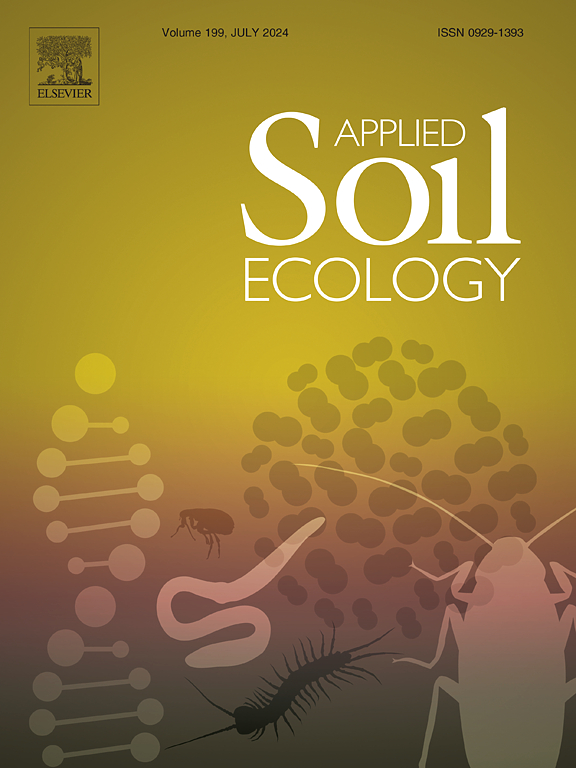Soil microbial attributes and soybean yield response to off-season crop diversification in an Oxisol in Southern Brazil
IF 4.8
2区 农林科学
Q1 SOIL SCIENCE
引用次数: 0
Abstract
Soybean (Glycine max) cropping in Brazil often relies on soybean/maize or soybean/fallow systems. Diversification with off-season crops can improve soil biological health and soybean yield. The aim of this study was to evaluate the effects of off-season crops on soil microbial attributes and soybean yield over a seven-year experiment carried out in Londrina, Paraná, Brazil. The treatments included five off-season cropping systems: (i) maize (Zea mays) and (ii) wheat (Triticum aestivum) as cash crops, (iii) ruzigrass (Urochloa ruziziensis) and (iv) showy rattlebox (Crotalaria spectabilis) as cover crops, and (v) fallow. Soil microbial attributes and soybean yield were assessed over 2020/2021 and 2022/2023 cropping seasons. Ruzigrass had the highest straw yield (8515 kg ha−1 year−1), while showy rattlebox produced the lowest amounts (509 kg ha−1 year−1) among the off-season crops. Ruzigrass and maize improved the soil organic carbon levels compared with fallow, whereas maize promoted the lowest amount of soil labile-C compared with the other treatments. Maize, ruzigrass, and wheat also increased the soil microbial biomass carbon. Cropping ruzigrass as off-season cover crop also improved N-cycling traits (microbial biomass N, and total inorganic N), microbial respiration, and the activity of β-glucosidase, arylsulfatase, acid phosphatase, and glutaminase. Principal component analysis of soil microbiological and chemical attributes revealed a separation among the off-season treatments, specially distinguishing ruzigrass from showy rattlebox and fallow. Ruzigrass provided the highest soybean yield in succession (4119 kg ha−1 year−1) compared with fallow (3525 kg ha−1 year−1). These results highlight ruzigrass as option to diversify the soybean production system, improving soil microbial attributes and soybean yield. Our findings also add on the understanding of crop diversification as sustainable agricultural strategy for promoting soil health.

巴西南部Oxisol地区土壤微生物属性和大豆产量对作物多样化的响应
巴西的大豆(Glycine max)种植通常依赖大豆/玉米或大豆/休耕系统。反季节作物的多样化可以改善土壤生物健康和大豆产量。本研究的目的是通过在巴西帕拉纳 Londrina进行的为期7年的试验,评估反季节作物对土壤微生物属性和大豆产量的影响。处理包括五种淡季种植制度:(i)玉米(Zea mays)和(ii)小麦(Triticum aestivum)作为经济作物,(iii)穗草(Urochloa ruziziensis)和(iv)响尾草(Crotalaria spectabilis)作为覆盖作物,(v)休耕。评估了2020/2021和2022/2023种植季土壤微生物属性和大豆产量。反季作物中,紫穗草秸秆产量最高,为8515 kg ha - 1年−1年−1年−1年−1年−1年秸秆产量最低,为509 kg ha - 1年−1年秸秆产量。与休耕相比,紫穗草和玉米提高了土壤有机碳水平,而玉米对土壤稳定碳含量的促进作用最低。玉米、穗草和小麦也增加了土壤微生物生物量碳。作为淡季覆盖作物种植,也改善了氮循环性状(微生物生物量N和总无机N)、微生物呼吸以及β-葡萄糖苷酶、芳基磺化酶、酸性磷酸酶和谷氨酰胺酶的活性。主成分分析结果表明,不同处理间土壤微生物和化学属性存在差异,特别是将细穗草与华盖草和休耕草区分开来。与休耕(3525公斤公顷- 1年- 1)相比,紫穗草连续提供了最高的大豆产量(4119公斤公顷- 1年- 1)。这些结果表明,紫穗草可以使大豆生产系统多样化,改善土壤微生物属性和大豆产量。我们的研究结果还增加了对作物多样化作为促进土壤健康的可持续农业战略的理解。
本文章由计算机程序翻译,如有差异,请以英文原文为准。
求助全文
约1分钟内获得全文
求助全文
来源期刊

Applied Soil Ecology
农林科学-土壤科学
CiteScore
9.70
自引率
4.20%
发文量
363
审稿时长
5.3 months
期刊介绍:
Applied Soil Ecology addresses the role of soil organisms and their interactions in relation to: sustainability and productivity, nutrient cycling and other soil processes, the maintenance of soil functions, the impact of human activities on soil ecosystems and bio(techno)logical control of soil-inhabiting pests, diseases and weeds.
 求助内容:
求助内容: 应助结果提醒方式:
应助结果提醒方式:


